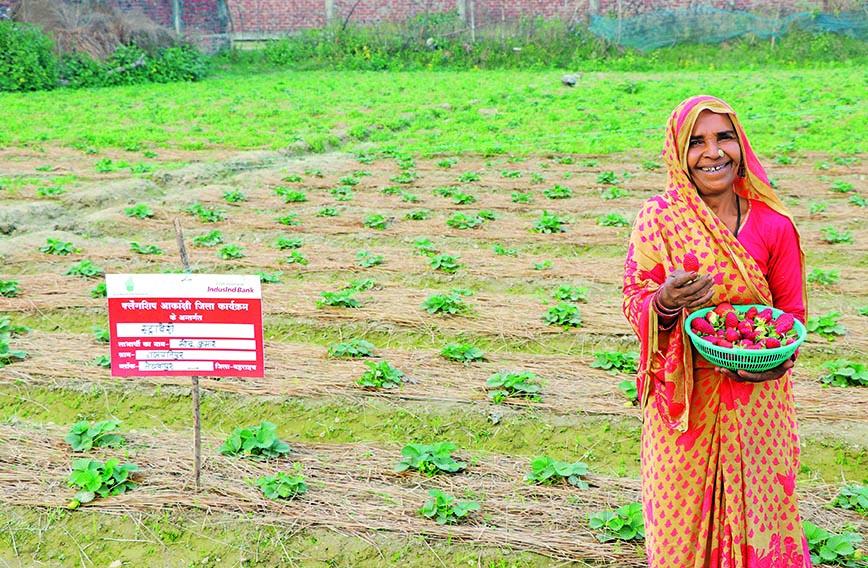
The popularity of the fruit in the homes of the women and the good returns from its sales have strengthened their resolve to invest in strawberry cultivation
Bahraich women celebrate a big strawberry boost
Usha Rai, Bahraich (UP)
THERE is palpable excitement in Gajpatipur village of Bahraich district in Uttar Pradesh (UP) where 10 women are cultivating organic strawberries on two acres for the first time. Farmers from Gajpatipur and neighbouring villages are arriving to take a look at the coveted new fruit carpeting fields in red and green. They too would like to grow the luscious fruit because of the lucrative income they could earn.
Thirty-six-year-old Siratul Nisha, one of the women cultivating strawberries, says, “I am not good at calculating the large amount earned on strawberries, but I know it will be in lakhs! My husband accompanies me to the market and does the calculation too. I am planning to grow strawberries again later this year.”
Some 30,000 plants are blooming. The first crop of strawberries has been harvested, packed neatly in boxes and sold in the mandi and markets of Bahraich. The strawberry season extends from October to mid-March.
It’s been a windfall, says Nisha, another strawberry cultivator. “One kg of strawberries fetches `250 in Bahraich. On an acre or from 15,000 plants we hope to harvest 7,500 kg of strawberries. We have two acres under strawberries in Gajpatipur so it will be a bonanza.” The fact that it is organically grown has added greater value to the fruit. The biofertilizer, a blend of cow dung, neem and other ingredients, is accessed from another group of women, also in Bahraich, who specialize in producing organic, home-made fertilizers for farmers.
Upesh Dubey, the agriculture specialist of the Aga Khan Foundation (AKF) which has sponsored the pilot project on strawberries, says the women, most of them in their twenties and thirties, are hard-working, disciplined and ambitious. Bahraich has been selected because it is an aspirational district in which the foundation integrates human, financial and technical resources to address the challenges faced by marginalized communities.
Each of these 10 women was selected from 30 farmer families who attended AKF’s Farmers Field School and are recognized for adopting best farming practices.
Rajkumari, just 22 years old, says, “The fruit is harvested in batches as it ripens. So, we pack two to four kg at a time and take it to the mandi. From my earnings from strawberries, I am saving enough to invest in the crop again next season.” Rajkumari, and Siratul, Munni, Suman, Shanti and Ramvati, will be using the money to improve their homes, add an extra room and some will be building their first pucca house. Money will also be spent for better education for children.
Almost every woman wants to use the additional income to improve irrigation facilities. Many women buy water from those who have a well or a boring. Dubey explains that the women now want to turn to solar power for irrigating their fields because it is so much cheaper. Eight of the 10 women in strawberry cultivation are members of AKF’s solar-powered irrigation system and pay at the rate of `2 per unit of water supplied to them.
Twenty-six-year-old Suman says she had no prior experience in growing strawberries. “I followed the training provided by the foundation and did exactly as instructed. I learnt that strawberries do not require excessive water and that proper irrigation management can yield better results.” She plans to invest the earnings from strawberry sales in her children’s education. Some money will be saved to grow high-value crops like broccoli and red, yellow and green capsicum. “I also want to arrange better irrigation facilities to ensure successful strawberry farming again,” she says.
Most of the women and their children have tasted strawberries for the first time and they love it. The popularity of the fruit in their homes and the good returns from its sales have strengthened their resolve to invest in strawberry cultivation. “Upeshji and AKF have spurred us to dream big and if more farmers take to strawberry cultivation our fruit may reach markets in Lucknow,” says Ramvati with pride.
Each woman has invested `50,000 for strawberry cultivation. Of this amount `30,000 was provided by AKF which in turn received the money from IndusInd Bank as its flagship CSR (corporate social responsibility) initiative. The remaining `20,000 is the contribution of the farmer herself for irrigation, fertilizers, etc. Each farmer is expected to make a profit of `2 to `2.5 lakh.
Irrigation has to be measured and done at the right time. The plants need to be protected from fog which can occur anytime in the 40 to 45 days of the crop cycle. So mulching or protection of the cultivated area with biomass is important. The strawberry stems are procured by the AKF from Hyderabad and 3,000 stems were given to each of the 10 women.
“Our training began early last year,” says Shanti. “We were taught the minutest details of strawberry cultivation… the distance between plants, the manure to be used, the exact measure of irrigation for the crop. In fact, we began by sowing the stem and when it started sprouting in a month, transplanted it into our earmarked fields.” From the harvested crop, stems can be cut and kept for the next two seasons.
There is almost a geometric pattern to the strawberry fields. The first lot of the fruit was packed and reached the mandi in January. “I forgot to tell you we were also taught packing,” Shanti chips in. “We are using plastic boxes this season. But, in keeping with environmental concerns, we are looking for non-plastic containers.”
If mangoes are the flavour of the summer season, the women of Bahraich are making strawberries the flavour of winter.
Comments
Currently there are no Comments. Be first to write a comment!





